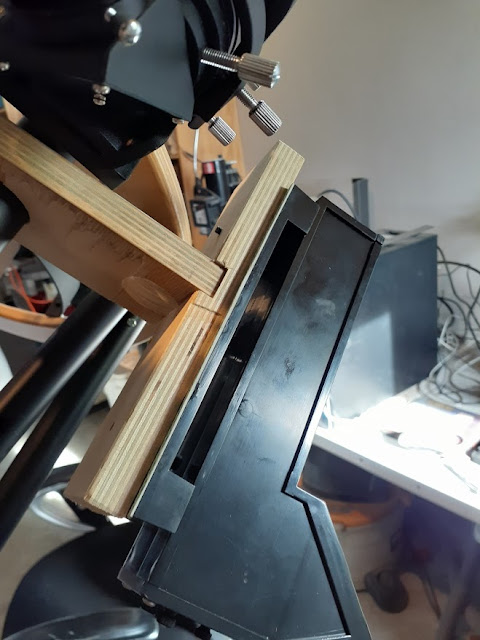A year and half ago, I bought a Telrad finder for the big scope. This is a 0 power device that projects several red circles in the field of view. For visible magnitude objects, it simplifies aiming the scope enough to use my 9x60mm finder for more precise aiming or sometimes the eyepiece itself. The Telrad is pretty large for the electronics it contains, and needs the exterior packaging redesigned, but it is a very nice addition to the scope. It has a mounting bracket intended to stick to a traditional telescope tube, which is not very useful on a Serrurier half truss tube (as is common on most big reflectors these days). So I built a mounting bracket that attaches in a very easy spot for attachment, but not so good for use.
The problem with this is that you have to get behind the scope to use it. Especially when aimed high in the sky, this involves getting nearly flat on the ground to look through it. How about putting it where the finder is located?
The finder is located as a stalk from a metal tube:
 |
The holder clamps on the metal tube. The scope maker's original finder assembly was for a different finder. I machined from acetal a different bracket a couple years ago. So I figured that I would do the same thing for the Telrad.
I decided to use Baltic birch to better match the scope. (In retrospect, I may redo it in black acetal to match the finder bracket.) This required two parts: the clamping assembly to lock on the 1.25" OD metal tube, and the piece that the Telrad base screws on to.
First step, cut the needed two pieces on the chop saw. Then square the pieces on the mill. This goes very quickly--it is wood, not aluminum. But the rough end mill did horrible things to the edges so I switched to a finish end mill.
Then I cut the 1.25" ID hole in the first piece, drilled a .28" hole through the side for the clamping bolt, and used a hacksaw to slice down to the hole so the clamping bolt can squeeze the wood onto the metal tube.
The second piece required a slot the width of the first piece that the first piece can slide into. (It will be bolted in that slot.) But my mill only has about three inches of Y travel, and the very nice milling vise that I bought recently takes away an inch or so of travel.
I have never mounted a workpiece directly on the table, so this was a learning experience.
There still did not seem to be enough Y-axis travel, so I moved the workpiece a bit forward, using a parallel to get a consistent distance from the back of the table.
Then I used a 1/4"-20 bolt from the base holding the Telrad mount to the piece that clamps on the pole.




No comments:
Post a Comment